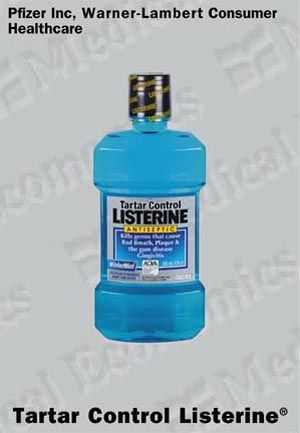 |
Active Ingredients: Thymol 0.064%, Eucalyptol 0.092%, Methyl Salicylate 0.060%, and Menthol 0.042.%.
Inactive Ingredients: Water, Alcohol (21.6%), Sorbitol Solution, Flavoring, Poloxamer 407, Sodium Saccharin, Benzoic Acid, Zinc Chloride, Sodium Benzoate, and FD&C Blue # 1.
Actions: To help prevent and reduce plaque and gingivitis, prevent tartar buildup, and fight bad breath. Use Tartar Control Listerine Antiseptic twice daily to help:
Tartar Control Listerine® Antiseptic has been shown to help prevent and reduce supragingival plaque accumulation and gingivitis when used in a conscientiously applied program of oral hygiene and regular professional care. Its effect on periodontitis has not been determined. Listerine is the only leading nonprescription mouthrinse that has received the American Dental Association' Council on Scientific Affairs Seal of Acceptance for helping to prevent and reduce plaque above the gumline and gingivitis.
Directions: Rinse full strength for 30 seconds with 20ml (2/3 fluid ounce or 4 teaspoonfuls) morning and night. If bad breath persists, see your dentist.
 |
Warnings: Do not administer to children under twelve years of age. KEEP THIS AND ALL DRUGS OUT OF THE REACH OF CHILDREN. Do not swallow. In case of accidental ingestion, seek professional assistance or contact a Poison Control Center immediately. Cold weather may cloud Tartar Control Listerine. Its antiseptic properties are not affected.
Store at 59° to 77°F.
How Supplied: Tartar Control.
Listerine® Antiseptic is suppled in 250 ml, 500 ml, 1.0 liter and 1.5 liter bottles, as well as 3 fl. oz. bottles.
 |